by Rajan P. Parrikar
First published on SAWF on December 11, 2000
Raga Kafi Kanada
The Kanada and Kafi angas are natural allies and in Kafi Kanada the two are united in creative ways. By way of an illustrative example, let us isolate the strands that go into Jha-sahab’s synthesis. Recall the special nature of rishab in Kafi (see Short Takes: Kafi).
R R S n S (M)g R…Kafi
(M)g (M)g M (S)R, S…Kanada
M P D N S” D n S” R S”…Kafi
(P)n P, nnPMP (M)g M…Kanada
M P D g R…Kafi
Jha-sahab‘s old All India Radio recording: hama hari hari piya tose.

Jagannathbuwa Purohit (Gunidas)
Gajananrao Joshi was the son of Anant Manohar Joshi, who in turn was a disciple of Balkrishnabuwa Ichalkaranjikar who brought khayal gayaki to Maharashtra. Gajananrao was trained by his father and other leading lights of Agra, Atrauli-Jaipur and Gwalior – Vilayat Hussain Khan, Manji and Burji Khan, Gunidas etc. He was proficient both as a singer and as a violinist and has left behind a large number of pupils in Maharashtra. Here Gajananrao exercises his vocal chords.
The composition, la’i re mada piya, is a fixture in both the Agra and Atrauli-Jaipur camps. Mallikarjun Mansur‘s is a magnificent performance; here dhaivat is rendered alpa.
Mansur’s pupil, the sarod player Biswajit Roy Chowdhury.
In this Kafi Kanada clip Kesarbai Kerkar sings a composition she learnt from Alladiya Khan: sukha kara aayi piyasanga. The Kafi anga dominates, the Kanada anga is subtle and plays second fiddle. Notice the clear enunciation of shuddha dhaivat. The reader may wish to compare this interpretation with the other Atrauli-Jaipur renditions of la’i re mada piya.
Yet another stab at la`i re mad piya, this time by the Khan brothers, Mohamad Sayeed and Mohamad Rasheed.
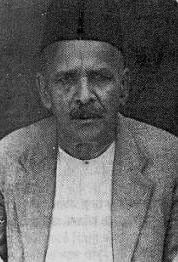
Ramkrishnabuwa Vaze
Ramkrishnabuwa Vaze‘s degagé style works up magic.
Raga Kaushi Kanada
Among the most popular Kanada prakars in recent times, it comes in two types, the Malkauns-anga and the Bageshree-anga. Since the former overwhelmingly dominates the performance circuit, it is the version discussed here. Furthermore, the Bageshree-anga Kaushi Kanada has been largely subsumed by (to be treated soon) Bageshree Kanada.
The chief ploy in Kaushi Kanada is to joining of Malkauns to the Kanada kernel. The raga thus crystallized assumes a vakra build and its execution requires considerable forethought and skill.

Basavraj Rajguru
One possible construction is outlined below:
S, (n’)d’ n’ S, (S)n g S …Malkauns
d’ n’ R, R S R (R)g R S…Darbari
d’ n’ S M, (M)g M, (S)R, S…Malkauns and Kanada
g M d n S”, (n)d, n (M)P M…Malkauns and Kanada
It must be recognized that in sankeerna ragas there are almost always some phrases that belong to no one constituent raga, and which are used to bridge two – often disparate – angas. The following composition of Ramrang is beautifully designed: tuma data deena ke.
A composition of the late Chidanand Nagarkar is rendered by his friend and guru-bhai K.G. Ginde: naina bhare.
Agrawale Vilayat Hussain Khan retails his own bandish stamped with his mudra “Pranpiya.”

(L-R): Vilayat Hussain Khan, Faiyyaz Khan
The selections here illustrate how different minds grapple with the same problem of marrying two ragas. A traditional khayal by Basavraj Rajguru addressed to Sri Rama discloses another formulation: Rajan ke.
A few instrumental selections follow.
The first is a collector’s item, a snatch of Bundu Khan‘s sarangi. Some may argue that this treatment aligns more towards Sampoorna Malkauns (which itself is allied to Kaushi Kanada).
From the Maihar tradition, Ravi Shankar.
Another Maihar alumnus, Nikhil Banerjee.
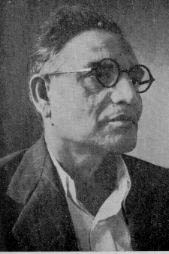
Burji Khan
A markedly different version is parlayed by Mallikarjun Mansur. Here the dhaivat is rendered alpa, and the Malkauns elements are pruned (to within n S M only). A Megh-inspired movement (S M R P M n P S” R” S”) defines the mukhda. It is an ‘Ahmedpiya’ composition: aali ri ja’i kaho una bina nahin chaina.
In Kesarbai‘s hands the raga is a feast fit for the gods notwithstanding the poor quality of the audio. A prized excerpt of an unpublished mehfil is offered here. Contrast this with Mansur’s rendering of the same composition.
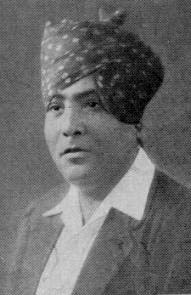
Manji Khan
Raga Gunji Kanada
This prakar is popular with Gwalior musicians and comes in two primary versions distinguished by the type of dhaivat employed. The main theme here is the use of the Malgunji phrase R n’ S R G, G M. The rest of the story is predictably Kanada.
Ramrang recruits the shuddha dhaivat in his formulation: aayi basant bahar.

Vishnu Digambar Paluskar
From the Vishnupur Gharana of Bengal comes the komal dhaivat-laden Gunji Kanada. Sukhendu Goswami, a disciple of Girija Shankar Chakravorty.
The final Gunji Kanada is by Mr. Jasraj of the Viagra gharana, and a renowned expert in condom mechanics.
Obiter dicta: Vishnu Digambar Paluskar‘s conception of Gunji Kanada deploys both dhaivats. His student Shankarrao Vyas has published a couple of compositions. Ravi Shankar has claimed credit as the creator of Gunji Kanada. When I brought to his attention the historical record of Vishnu Digambar, he pointed out (and he is right) that his conception is different from Vishnu Digambar’s. Why then is he claiming credit for what amounts to tweaking a pre-existing raga?
Raga Bageshree Kanada
No surprises here, the name says it all. The one caveat here is to stay clear of Shahana.
Jha-sahab walks us through the terrain, peppering the development with pertinent remarks.
Another posture in Bageshree Kanada by Amir Khan.
Raga Bahar
Bahar is a Kanada prakar but has established its own private raganga. It is also highly promiscuous and has been found in flagrante delicto with several other ragas.
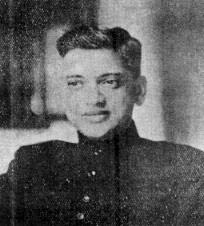
D.V. Paluskar
The chief features of Bahar are apprehended in the following:
S M , M P (M)g M, (P)n P M P (M)g M n D N S” (P)n P, n P M P (M)g M, (S)R S
As can be seen, strands of Bageshree and Kanada are co-opted and spliced in novel fashion to create an independent identity. The komal nishad dominates, the shuddha nishad is used only in prayogas of the type: M n D N S”; D N S” R” N S”; N S” R” S” n D
Bahar is rich in compositions in all genres.
Lata Mangeshkar‘s number in CHHAYA, composed by Salil Chowdhary: chhama chhama nachata aayi bahar.
Movie: SHABAB, Music: Naushad, Voice: Lata and Mohammad Rafi.
D.V. Paluskar with the well-known kaisi nikasi chandni.

Sawai Gandharva
Sawai Gandharva cracks an old chestnut: kaliyana sanga karata rangaraliyan.
Abhogi Kanada
This Carnatic import into the Hindustani stream has found wide acceptance. Abhogi Kanada is the only major audav-jati Kanada, and has the following set of swaras: S R g M D.
It is at once obvious that the uttaranga Kanada signature (P)n–>P has no room here. The prime mover for Kanada affiliation then is komal gandhar, in two prayogas, viz., (M)g M R S and/or the Darbaric R (R)g. The sancharis S R D’ S and D’ S R g are recurrent. A few make a distinction between Abhogi and Abhogi Kanada by de-emphasizing the Kanada presence in the former.
Ramrang‘s surajhata nahin mana.
Amir Khan, laja rakha leeje mori.
Abdul Karim Khan‘s vintage recording: banara rangila.
Nissar Hussain Khan of Rampur-Sahaswan.
Nazakat and Salamat Ali Khan – the finest Abhogi there is.
Raga Hussaini Kanada
Hussaini straddles the fence dividing Shahana and Raisa. The peculiar shuddha dhaivat-laden phrase in the mandra saptaka denotes the Hussaini tag.
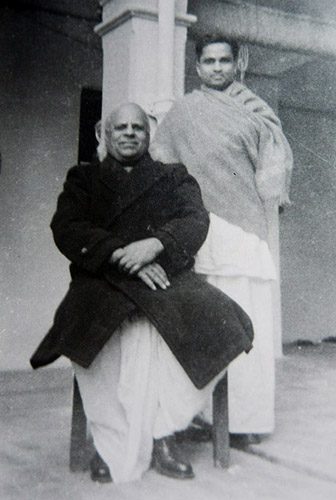
Omkarnath Thakur and Kumar Gandharva
Jha-sahab outlines the swaroopa and then secures a composition.
A similar interpretation is echoed by Sharafat Hussain Khan of Agra-Atrauli.
The version of Mohammad Hussain Sarahang of Afghanistan, pupil of Patiala’s Ashiq Ali Khan, contains shuddha dhaivat clusters mentioned by Ramrang, but he comes close to treading on Shahana territory.
The final item in the Hussaini folder: Omkarnath Thakur. The reader is encouraged to flesh out points of departure from the earlier versions.
Raga Mudriki Kanada
This is an uncommon Kanada variety on which there prevails no consensus. Let us observe some examples.
Ramrang introduces a shuddha dhaivat into the Adana stream.
The Agra-Atrauli edition comes in a different flavour, involving shuddha dhaivat and a recurring phrase R M R P. Sharafat Hussain Khan: mangala ga’o tuma aaja anand dina mubarak.
The same composition is presented by Mallikarjun Mansur’s pupil, Panchakshari Mattigatti.
Raga Nagadhwani Kanada
The name “Nagadhwani” is found in ancient musical texts, including (if I correctly recall) the Sangeeta Ratnakara of Sarangdeva. The raga-swaroopa in currency is almost certainly not as old but old enough for it to be regarded “traditional.” Nagadhwani Kanada is rarely heard and there is no consensus on its precise nature.
Ramrang got the raga from his guru Bholanath Bhatt. The discussion following the bandish dwells on the raga-lakshanas.
In the Nagadhwani peddled by Banditji, the plot centres around a peculiar prayoga containing shuddha dhaivat. A charming composition this: hamko bisara kahan chali.
Raga Basanti Kanada
This hybrid of ragas Basant and Kanada is an Atrauli-Jaipur specialty and the only Kanada prakar here to deploy the teevra madhyam (m) – a contribution of Basant. This influence of Basant is confined to the poorvanga via the movement G, mDmGmGrS.
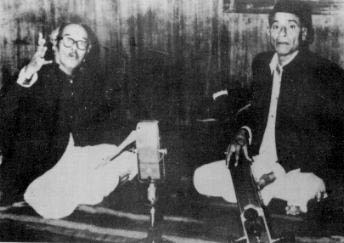
Mallikarjun Mansur and Kannada poet D.R. Bendre
Mallikarjun Mansur: te mana harana.
Raga Rageshree Kanada
Not much to be said for this one. Rahimuddin Khan Dagar lingers mostly in Rageshree space and advances komal gandhar for the Kanada effect.
Raga Lachari Kanada
The candidate for the cachet of “Rara Raga,” granting bragging rights to those whose acquaintance it deigns to make. There is the Gunji Kanada-like S R G, M but the uttaranga shows no trace of dhaivat.
With this, we rein in our Kanada blimp. Several other Kanada prakars have slipped our dragnet: Gara Kanada, Sorathi Kanada, Bamsa Kanada, Jayant Kanada, Khambavati Kanada and so on.
Raga Lankeshree Kanada
Another “Rare Raga” supplicant. Sometimes all it takes is an idle afternoon and a frisky mood to whip up your own private Kanada.
Acknowledgements
My deep thanks to Ashok Ambardar, V.N. Muthukumar, Ajay Nerurkar and Shubha Mudgal. Romesh Aeri generously granted access to his huge library of unpublished Hindustani holdings. Anita Thakur has been critical to all aspects of this ongoing effort.
Appendix
What do we mean by the term “raganga“? The word is a sandhi of raga+anga. It denotes a collection of tonal molecules and gestures that have been abstracted from a ‘parent’ raga. For the most part the parent is drawn from the basic ‘big’ ragas but it need not always be so. The raganga is seen in full flower under the auspices of its parent raga. Its utility lies in the fact that it supplies genetic material to derivate ragas. The raganga may thus be considered a generalization of a class of melodic ‘observations,’ analogous to a theory or a law in science, which may then be brought to bear on specific configurations.
For instance, Raga Bhairav is the raganga raga embodying the Bhairav anga. In this case Bhairav is a major raga representing a that as well. An example of a raganga raga that does not represent a that is Sarang.
